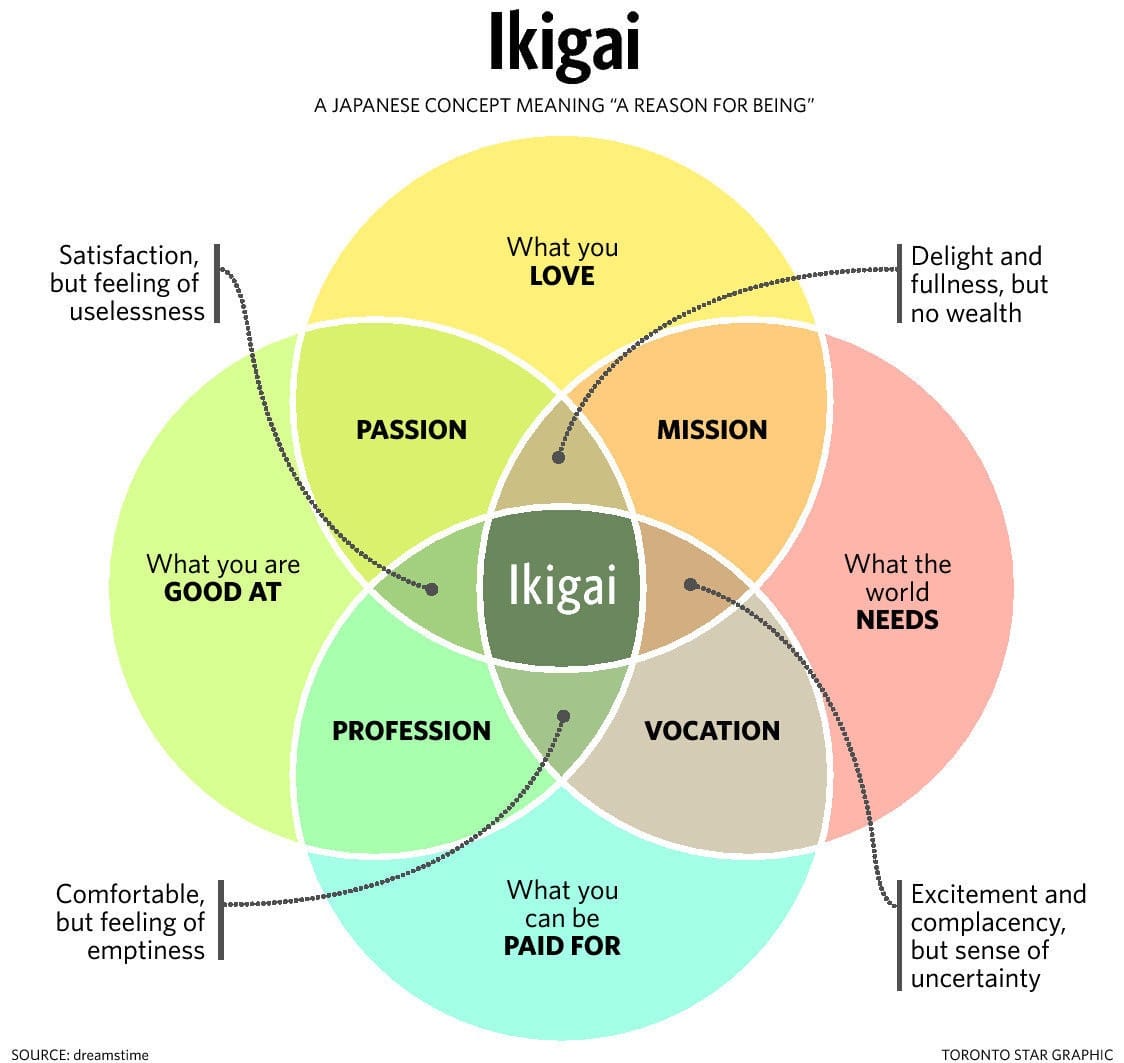Ikigai for Teams
Summary
- Ikigai is about improving your personal sense of fulfillment by aligning your work in four dimensions: what you’re good at, what you love, what the world needs, and what you can be paid for.
- The Ikigai concept and dimensions can be applied effectively to entire teams, too.
- This article offers suggestions for specific actions that leaders (not just managers) can take to boost their team’s alignment with each of the four Ikigai dimensions and bring the whole team closer to the center of the Ikigai diagram.
Hot Take
Ikigai is a Japanese concept that’s usually applied to help oneself find a more fulfilling path in life, but I find it works just as well when applied to whole teams. A team whose members feel more fulfilled in their work and workplace in the Ikigai dimensions will outperform teams that are not so aligned.
What is Ikigai All About?
Ikigai (pronounced i-key-guy) is a concept that originated in Japan as a way of thinking about one’s activities and how they contribute toward living a fulfilling life. This approach views work across four dimensions, which you can think of a overlapping circles in a Venn diagram:

Briefly, “What You’re Good At” is work where you have skills, expertise, and talent; the “What You Love” circle is where activities you’re passionate about go; “What the World Needs” are things that make the world better in some way, be it economically, physically, or spiritually; and finally “What You Can Be Paid For” is self explanatory—that’s work someone will actually give you money to do. These categories are a good fit for a Venn diagram because so many things we do fall into one or more, but possibly not all, of these categories: for example, you may love writing poetry and the world could certainly use more of it… but is it any good? And sadly, even if it’s good, it’s unlikely anyone will pay you much for it.
Ikigai is the philosophy that you’ll feel most fulfilled in life if you are aware of which circles your activities fall into, and focus especially on those that are in the center, where your passion, mission, vocation, and profession are all aligned.
Ikigai and Me
I’ve been lucky enough to be at the central sweet spot in multiple jobs in my career. That doesn’t mean they were always pleasant or enjoyable—just that I felt I was “in the right place”. Conversely, I’ve had jobs where despite earning high praise and large bonuses, something felt “off” and unsatisfying. Looking back, I tried mapping some jobs I’ve had of each type to points in the Ikigai diagram, and… in my case at least, it all fit and made sense: the “good” jobs were ones in my Ikigai center, and the ones I didn’t like tended to outside the “What I Love” and/or “What the World Needs” circles. Starting this newsletter was a direct, conscious consequence of applying the Ikigai concept to find work where all four circles align (a story for another day!).
I’ve found Ikigai to offer useful insights in my own life, but it doesn’t fit everyone, or all situations. For example, there are more than just four important areas in our lives, and not everyone wants to merge the separate circles (some want or need to keep work and the rest of their lives separate, for example). I should point out, too, that sometimes it can require privilege to live at the center of the Ikigai diagram. I would counter those limitations, though, by quoting George Box, who once said, “all models are wrong, but some are useful”. Ikigai has some shortcomings, but it’s useful.
Team Ikigai
Management books are full of lists of things that can be done to improve team performance, often memorialized in overwrought acronyms, or presented as laundry lists only partially unified into vague concepts. Ikigai is usually thought of in the context of personal fulfillment and career planning, but I think can be applied equally well in a team environment… and it has the advantage of being simple, intuitive, and elegant.
Teams, like individuals, thrive when their work resonates on all four Ikigai dimensions. Enjoyment, skill, purpose, and recognition are not just personal needs but collective ones. There’s a body of research (see, for example, the material in the “Want to Learn More?” section, below) that shows when teams align on these fronts, productivity, velocity, and delivery—to say nothing of morale—get a big boost.
Teams need to satisfy the same four needs; here’s how you can apply the Ikigai circles to team wellbeing:
- What They Love: Teams will perform better if they enjoy their work and have fun with it; everything will run better if team members look forward to working together, rather than dreading it. In a team context, the “love” we're talking about is that individual team members feel a sense of belonging to the team, feel safe, and enjoy the company of other team members. There is a joy that comes from the feeling of being recognized and valued by your teammates. This clearly applies to sports teams, and it applies to work teams, too.
- What They’re Good At: The team as a whole should have the skills and experience needed to deliver, be confident in those skills, and be able to work together effectively to combine their skills (like the Power Rangers). For the team to be really good at something, they need a combination of individual capability and teamwork.
- What the World Needs: In the context of a workplace this is about whether the team has a sense of purpose around what they’re doing. The team needs to understand their role and believe in what they’re doing, and to see it as serving a higher purpose than just delivering formal quarterly objectives.
- What They Can Be Paid For: This is about the larger organization and company visibly valuing the work the team is doing. To continue to exist as a team and get paid, the upper management needs to perceive the value of their work, and be willing to support them through budgets, headcount, “air support”, and recognition. If the team is constantly fighting for adequate funding, or not being encouraged by senior executives, their heart won’t be in it, and some of them will be looking for the exits—they’ll want to find another team where they can have an impact that’s valued by the business.
The same as for individuals, the work of teams can be in one, two, three, or all four circles. Like individuals, they might find fulfillment by covering different circles with different projects. The best place to be, though, for fulfilling high performance, is in the center. Those teams not only deliver, but the team members fondly remember the experience and magic years later.
Leaders and Team Ikigai
A recurring theme in this newsletter is that “leaders” and “people managers” are two different things (though they can overlap). There are certainly situations where people managers can apply their management-specific “superpowers” to improve the Ikigai of their team, but I personally find it more interesting to look at what leaders can do, whether they are managers or individual contributors.
Let’s think about some ways leaders can have an intentional and positive influence on their team’s Ikigai.
- What They Love (team members love being part of the team):
- Celebrate together: arrivals and departures of team members, birthdays, promotions.
- Social activities: have a team lunch together, team tea time, group outing to do an escape room, or go to a movie together.
- Publicly acknowledging contributions of team members. For example, one team I was on had a standing agenda item at every team meeting to open the floor to anyone to say “thanks” to anyone else on the team for something they’d done during the past week.
- Be allies for, and support each other, by calling out unconscious bias.
- Practice “blameless postmortems” to review what worked well in a project, what didn’t, and how to improve.
- If your team works substantially remotely, find opportunities to get together in person from time to time. Most modern knowledge work can be done perfectly well over the internet (that's the What They're Good At circle), but the sense of belonging that's so important in this Ikigai circle (What They Love) is hard to maintain, and hard for newcomers to the team to establish, without some face-to-face relationship building.
- What They’re Good At (team members have both the skills needed, and the ability to combine their skills):
- Sign up for education programs and invite team members to join you.
- Set up regular knowledge sharing opportunities, like “brown bag” lunches, where team members take turns teaching each other about something relevant to the team’s work in an informal setting.
- Mentor and coach less experienced team members, or introduce them to people outside the team who can do so.
- Tackle projects as a team, rather than as a collection of individual efforts—even if the projects aren’t large enough to normally require more than one person. Engineers often operate this way with a "Tech Lead" guiding a small team, but I've had success with this approach with Program Managers, too: instead of each Program Manager handling a set of projects on their own, organize so that a collection of projects (a "portfolio") is handled by a a team that works them together, with a senior person on the team acting as lead.
- What the World Needs (sense of purpose beyond immediate objectives):
- If your team doesn’t already have a vision and mission (or the ones you have don't resonate with the team), build consensus around a new vision and mission. I’ll have more to say about this in future newsletters, but for now I'll just say: they need to be meaningful, memorable, actionable, short... and everyone on the team needs to be able to see themselves and their work in that vision and mission.
- Invite customers (internal or external) to meet with the team to talk about what the team’s work means to them, and how they use it.
- Hold “show and tell” sessions with adjacent teams you work with to boost understanding of how the team’s work fits into a larger picture.
- Develop and track “impact metrics” that demonstrate the value your team brings to the larger company. These aren’t just “we delivered three weeks early”: think about how you could estimate cost savings or increased revenue resulting from the team’s work, and talk about that.
- Ask upper management to speak to the team (or just have lunch with the group—they have to eat sometime, right?) and talk about how the team fits into a larger strategic picture.
- What They Can be Paid For (team’s work is valued by the larger business):
- Schedule periodic review sessions with senior executives to educate them about the team’s work and contributions, and ask their advice.
- Create opportunities for team members to be “on stage”, presenting and explaining their work, and interacting with members of other teams and senior management.
- Use data-driven communications with other teams and executives: don’t say “we completed our project”, say “we saved $X per engineer per month”. Always translate deliverables into business impacts.
- Identify, recruit, and encourage executive champions and project sponsors—senior people who don’t need to be involved in the details of the team’s work, but who will advocate for the team and give it increased visibility.
How You Can Bring Order From Chaos, Today
I find “Team Ikigai” is a simple, intuitive, model that can help me think about improving team performance in a natural way. I hope you find the same!
Here are some actions you can take today to begin to apply these ideas:
- Make an Ikigai inventory for yourself. Start by drawing four overlapping circles, and then write what you personally love doing, are good at, etc. into the appropriate circles. Don’t stop with the obvious ones—try to think of multiple items you can add to each area of the diagram. Ask yourself what you could do to bring items that are only in one or two circles into more circles, or to spend more time in the central overlap. Take a class? Join a community group? Add a side project? Change jobs? Be creative, and try to think across multiple circles in the diagram.
- Make an Ikigai inventory for your team. Same exercise as above, but do it for team members, recognizing that different people on the team will, of course, be in different places and bring different passions, and skills to the party. Ask yourself how you and other leaders could develop the team and team members to move everyone closer to the center. Training? Creating a new team mission? Team social events? Be creative.
- Look through the suggested actions in the Leaders and Team Ikigai section, and pick one or two that you could try out quickly... then do so!
- Ask for feedback from friends and family members about your own Ikigai diagram, or from co-workers about your team diagram. Listening to other perspectives can not only be illuminating, but can help you get validation and ongoing encouragement as you work to move yourself or your team toward the center.
Want to Learn More?
The following books go into more depth about the general concept of Ikigai and its application. The first book was responsible for popularizing it outside Japan; the other two don’t mention Ikigai explicitly, but rather talk about data-driven approaches to improving team performance using similar philosophies. (Note that these are affiliate links—I may receive some compensation, at no cost to you, if you purchase these books after clicking on these links).
- Ikigai: The Japanese Secret to a Long and Happy Life, by Héctor García and Francesc Miralles, 2016
- Work Rules!: Insights from Inside Google That Will Transform How You Live and Lead, by Laszlo Bock, 2015
- Trust Factor: The Science of Creating High-Performance Companies, by Paul J. Zak, 2017
What Do You Think?
I'd love to hear about your experiences with Ikigai, both individually and within teams! If you're a paid supporter of this newsletter (hint, hint!) you can add comments below (comments will be visible to everyone).


